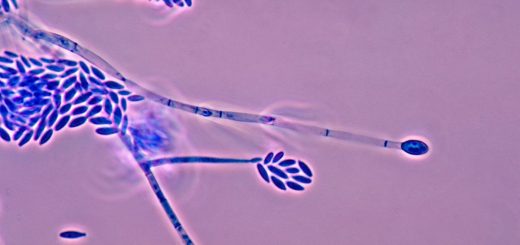#093: Orellanine
This toxin is present in only a few mushrooms of the Cortinarius genus, so poisonings from this mushroom are relatively rare (at least recently). The two mushrooms responsible for most orellanine poisonings are Cortinarius orellanus and rubellus, commonly known as Lethal Webcaps. These mushrooms are primarily found in Europe, but are sometimes encountered in the United States. Closely related mushrooms that also contain orellanine are known as Fool’s Webcaps.
Orellanine (also called orellanin) poisoning has the longest latent period of all mushroom toxins. The initial symptoms resemble the flu and appear between 12 hours and 3 days after consumption. These symptoms include nausea, diarrhea, vomiting, and anorexia. Orellanine primarily attacks your kidneys, and kidney function gradually decreases after the initial symptoms appear. The symptoms of renal failure – extreme thirst, frequent urination, and decreased kidney output – develop after 3 to 15 days in cases of severe poisoning or after 10 to 17 days in cases of mild poisoning.
Treatment of orellanine poisoning is focused on alleviation of symptoms, as no antitoxin exists. In mild cases, kidney function is impaired for a time but gradually returns on its own. In severe cases, the kidneys shut down completely, leaving the patient reliant on dialysis or a kidney transplant in order to live. Treatment with corticosteroids and antioxidants may help the patients regain kidney function, although the sample size for this treatment is too small to prove its effectiveness.
Poisoning by orellanine is infrequent. Most of the time, an individual mistakes a Lethal Webcap for an edible mushroom such as Cantharellus tubaeformis or a hallucinogenic mushroom such as a Psilocybe species. Treatment may be confused in the latter case, as doctors would initially suspect an entirely different set of toxins. The worst case of orellanine poisoning was a mass poisoning event that occurred in Ponzan, Poland in 1952. 102 people in the town became sick with a mysterious disease that impaired kidney function. Although this was the first important poisoning attributed to the Cortinarius genus, doctors managed to identify the culprit: a batch of C. orellanus mushrooms that all those infected had consumed a few weeks beforehand. The diligent records of symptoms kept by the epidemiologist Stanislaw Grzymala allowed him to later identify orellanine as the primary toxic agent in Lethal Webcaps.
Orellanine is a tetrahydroxylated di-N-oxidized bipyridine, which is a fairly small molecule. It is composed of two connected pyridine molecules (a benzene ring with a nitrogen atom substituted for one of the carbon atoms; 5C1N), each with one oxygen atom bound to the nitrogen and two OH groups each bound to a carbon atom. In this configuration, the nitrogen-bound oxygen atoms are negatively charged and the nitrogen atoms are positively charged. Orellanine has another possible conformation of its atoms. In this alternate configuration, the nitrogen atoms are bound to OH groups, one carbon in each ring is double-bound to an oxygen atom, and another carbon in each ring is bound to an OH group. The second conformation does not have any charged atoms, so you might expect it to be more stable than the first. However, due to the oxygen-carbon double bonds, there are only two double bonds in each six-atom ring. The first conformation has three double bonds in each ring, which forms a highly stable molecular orbital. Orellanine can easily switch between the two configurations (a.k.a. “tautomers”), but because the first form is more stable, the molecule spends more time in that configuration.
So how does orellanine work? We don’t really know. Two similar compounds – paraquat (methylviologen) and diquat – are commonly used as herbicides and are also nephrotoxic (kidney-destroying). Whether or not orellanine’s toxic effects are achieved through the same mechanism of action as paraquat and diquat is undetermined. After ingestion, orellanine quickly becomes concentrated in the kidneys, where most of the damage occurs. Kidney biopsies have revealed that orellanine can persist in the kidneys for as long as six months. It is not surprising that orellanine is toxic, since its preferred tautomer contains a charged oxygen atom. This may allow orellanine to wreak havoc on various reduction and oxidation reactions within cells, thus preventing them from functioning properly. Antioxidants may help reduce this damage by preventing extraneous oxidation reactions.
See Further:
http://naturespoisons.com/2014/04/08/orellanine-kidney-failure-by-mushroom/
http://www.botany.hawaii.edu/faculty/wong/BOT135/Lect18.htm (see “Group III,” 2/3 down the page)
http://www.mykoweb.com/TFWNA/P-32.html
http://www.first-nature.com/fungi/cortinarius-orellanus.php
http://www.ncbi.nlm.nih.gov/pubmed/23046414
http://www.ncbi.nlm.nih.gov/pubmed/3196164








![#011: Characteristics of Kingdom Fungi [Archived]](https://www.fungusfactfriday.com/wp-content/themes/hueman/assets/front/img/thumb-small-empty.png)


1 Response
[…] ranging from gastrointestinal upset to death. The most dangerous webcaps contain orellanine (FFF#093), a compound that destroys kidney function. A few species are considered edible, but the chances of […]